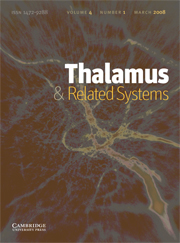Crossref Citations
This article has been cited by the following publications. This list is generated based on data provided by
Crossref.
Poolos, Nicholas P.
2005.
The h-channel: A potential channelopathy in epilepsy?.
Epilepsy & Behavior,
Vol. 7,
Issue. 1,
p.
51.
Ying, Shui‐Wang
Abbas, Syed Y.
Harrison, Neil L.
and
Goldstein, Peter A.
2006.
Propofol block ofIhcontributes to the suppression of neuronal excitability and rhythmic burst firing in thalamocortical neurons.
European Journal of Neuroscience,
Vol. 23,
Issue. 2,
p.
465.
Abbas, S.Y.
Ying, S.-W.
and
Goldstein, P.A.
2006.
Compartmental distribution of hyperpolarization-activated cyclic-nucleotide-gated channel 2 and hyperpolarization-activated cyclic-nucleotide-gated channel 4 in thalamic reticular and thalamocortical relay neurons.
Neuroscience,
Vol. 141,
Issue. 4,
p.
1811.
Cataldi, M.
Lariccia, V.
Marzaioli, V.
Cavaccini, A.
Curia, G.
Viggiano, D.
Canzoniero, L.M.T.
di Renzo, G.
Avoli, M.
and
Annunziato, L.
2007.
Zn2+ Slows Down CaV3.3 Gating Kinetics: Implications for Thalamocortical Activity.
Journal of Neurophysiology,
Vol. 98,
Issue. 4,
p.
2274.
Young, Calvin K.
and
Eggermont, Jos J.
2009.
Coupling of mesoscopic brain oscillations: Recent advances in analytical and theoretical perspectives.
Progress in Neurobiology,
Vol. 89,
Issue. 1,
p.
61.
Kelmendi, Benjamin
Holsbach-Beltrame, Márcia
McIntosh, Andrew M.
Hilt, Lori
George, Elizabeth D.
Kitchen, Robert R.
Carlyle, Becky C.
Pittenger, Christopher
Coric, Vladimir
Nolen-Hoeksema, Susan
Sanacora, Gerard
and
Simen, Arthur A.
2011.
Association of polymorphisms in HCN4 with mood disorders and obsessive compulsive disorder.
Neuroscience Letters,
Vol. 496,
Issue. 3,
p.
195.
Kanyshkova, Tatyana
Meuth, Patrick
Bista, Pawan
Liu, Zhiqiang
Ehling, Petra
Caputi, Luigi
Doengi, Michael
Chetkovich, Dane M.
Pape, Hans-Christian
and
Budde, Thomas
2012.
Differential regulation of HCN channel isoform expression in thalamic neurons of epileptic and non-epileptic rat strains.
Neurobiology of Disease,
Vol. 45,
Issue. 1,
p.
450.
Klueva, Julia
de Lima, Ana D.
Meis, Susanne
Voigt, Thomas
and
Munsch, Thomas
2012.
Hyperpolarization-Activated Cation Current Contributes to Spontaneous Network Activity in Developing Neocortical Cultures.
Neurosignals,
Vol. 20,
Issue. 1,
p.
35.
Shaikh, Aasef G.
Optican, Lance M.
and
Zee, David S.
2013.
Mechanisms and Emerging Therapies in Tremor Disorders.
p.
11.
Albertson, Asher J.
Williams, Sidney B.
and
Hablitz, John J.
2013.
Regulation of epileptiform discharges in rat neocortex by HCN channels.
Journal of Neurophysiology,
Vol. 110,
Issue. 8,
p.
1733.
Shah, Mala M.
Huang, Zhuo
and
Martinello, Katiuscia
2013.
HCN and KV7 (M-) channels as targets for epilepsy treatment.
Neuropharmacology,
Vol. 69,
Issue. ,
p.
75.
Ulrich, Daniel
2014.
Subthreshold delta‐frequency resonance in thalamic reticular neurons.
European Journal of Neuroscience,
Vol. 40,
Issue. 4,
p.
2600.
Baker, Rowan
Gent, Thomas C.
Yang, Qianzi
Parker, Susan
Vyssotski, Alexei L.
Wisden, William
Brickley, Stephen G.
and
Franks, Nicholas P.
2014.
Altered Activity in the Central Medial Thalamus Precedes Changes in the Neocortex during Transitions into Both Sleep and Propofol Anesthesia.
The Journal of Neuroscience,
Vol. 34,
Issue. 40,
p.
13326.
Scharfman, Helen E.
and
MacLusky, Neil J.
2014.
Sex differences in the neurobiology of epilepsy: A preclinical perspective.
Neurobiology of Disease,
Vol. 72,
Issue. ,
p.
180.
Cho, Frances S.
Clemente, Alexandra
Holden, Stephanie
and
Paz, Jeanne T.
2017.
Models of Seizures and Epilepsy.
p.
273.
Bellot-Saez, Alba
Cohen, Greg
van Schaik, André
Ooi, Lezanne
W Morley, John
and
Buskila, Yossi
2018.
Astrocytic modulation of cortical oscillations.
Scientific Reports,
Vol. 8,
Issue. 1,
Amarillo, Yimy
Tissone, Angela I.
Mato, Germán
and
Nadal, Marcela S.
2018.
Inward rectifier potassium current IKir promotes intrinsic pacemaker activity of thalamocortical neurons.
Journal of Neurophysiology,
Vol. 119,
Issue. 6,
p.
2358.
Zobeiri, Mehrnoush
Chaudhary, Rahul
Datunashvili, Maia
Heuermann, Robert J.
Lüttjohann, Annika
Narayanan, Venu
Balfanz, Sabine
Meuth, Patrick
Chetkovich, Dane M.
Pape, Hans-Christian
Baumann, Arnd
van Luijtelaar, Gilles
and
Budde, Thomas
2018.
Modulation of thalamocortical oscillations by TRIP8b, an auxiliary subunit for HCN channels.
Brain Structure and Function,
Vol. 223,
Issue. 3,
p.
1537.
Zobeiri, Mehrnoush
Chaudhary, Rahul
Blaich, Anne
Rottmann, Matthias
Herrmann, Stefan
Meuth, Patrick
Bista, Pawan
Kanyshkova, Tatyana
Lüttjohann, Annika
Narayanan, Venu
Hundehege, Petra
Meuth, Sven G
Romanelli, Maria Novella
Urbano, Francisco J
Pape, Hans-Christian
Budde, Thomas
and
Ludwig, Andreas
2019.
The Hyperpolarization-Activated HCN4 Channel is Important for Proper Maintenance of Oscillatory Activity in the Thalamocortical System.
Cerebral Cortex,
Vol. 29,
Issue. 5,
p.
2291.
Schwerin, Stefan
Westphal, Catharina
Klug, Claudia
Schneider, Gerhard
Kreuzer, Matthias
Haseneder, Rainer
and
Kratzer, Stephan
2022.
Sedative Properties of Dexmedetomidine Are Mediated Independently from Native Thalamic Hyperpolarization-Activated Cyclic Nucleotide-Gated Channel Function at Clinically Relevant Concentrations.
International Journal of Molecular Sciences,
Vol. 24,
Issue. 1,
p.
519.

